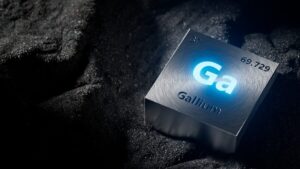Niobium’s on the radar of major world economies, but what is it and what is it used for?

Pic: Getty Images
- Is surging investor interest in niobium more than just a flash in the pan?
Niobium has caught the eyes of punters thanks to a spectacular discovery a few weeks ago by WA1 Resources (ASX:WA1) in a fairly remote part of the world, around 493km south of Halls Creek in Western Australia’s Kimberley region.
The former $3m market cap minnow (now ~$92.28m) hit niobium-rare earths paydirt in its first hole at the P2 target, part of the West Arunta Project, with hits such as 54m at 0.62% niobium, 0.18% rare earths and 3.85% phosphorus from 162m.
News of the breakthrough sent WA1’s share price flying 220% on the day with the company’s managing director Paul Savich describing the discovery of a mineralised carbonatite system in the West Arunta as ‘the first of its kind’.
But what exactly is niobium and what is it used for?
READ: Has WA1’s niobium-rare earths discovery unlocked a new mineral province?
Niobium in steel
Often confused and misinterpreted as part of the rare earth family, niobium’s bread and butter is in the making of high-strength, low-alloy steel (HSLA), which accounts for around 90pc of its overall demand.
Adding a very small amount of ferroniobium (an alloy of iron and niobium) to steel makes it lighter and stronger, perfect in areas such as construction for use in oil and gas pipelines as well as in the aviation and transport sectors helping to reduce overall weight, improve fuel efficiencies and reduce emissions.
As a refractory element, niobium is also highly resistant to heat and water and is a great superconductor in applications such as in magnets in the manufacture of MRI scanners, nuclear magnetic resonance (NMR) medical diagnostic equipment, and Maglev trains which travel at speeds of up to 430kmh along a magnetic railway.
Its resistance to physiological corrosion and biocompatibility means it can adapt to any sterilisation method and is therefore used in the manufacture of bone plates, dental implant roots, surgical appliances, and skull plate bone screws.
Niobium in battery applications
There are also many developing use cases for the niche metal, for example as a superconductor material in battery applications where niobium titanium oxide is being explored as a next generation anode material for large scale energy storage.
But according to capital markets veteran and resources analyst, Peter Strachan, these will take years to come online.
“Everyone is looking for the new lithium – WA1 went from $0.15 to $1.90 after its discovery of the stuff but I think this will end in tears because it’s the sign of a very hot market,” he says.
“There was a big push for nickel and then cobalt and now Tesla is using lithium iron phosphate batteries, which have no nickel or cobalt in them at all.
“The chemistry for these solid-state batteries is changing very, very rapidly and now CATL – the big Chinese battery maker – is making sodium-ion batteries because lithium has become so expensive,” Strachan explains.
“I think investors should be very cautious – there is a lot of hype around niobium at the moment, it’s the new black in the whole pantheon of battery metals but I think it might be a flash in the pan.”
Even if niobium’s value in the battery sector has been overblown, it is worth pointing out this doesn’t detract from its traditional uses.
The world’s biggest niobium producers
Niobium is on the critical mineral lists of several countries around the world including Australia, Japan, the EU, India and the US – meaning it is considered vital for modern technologies, economies, and even our national security. Yet the supply chain is at risk.
There are only three mines in the world that make niobium as their primary product and there have been no new mines brought into production since the mid-1970s.
CBMM in Brazil is the world’s largest producer, supplying about 84pc of the global market near the city of Araxá.
Most of the rest of the world’s niobium supply comes from China Molybdenum’s Boa Vista Mine in Brazil, which it acquired from Anglo American in 2016 and Canadian company Magris Resources’ Niobec Mine in Quebec.
These three producers collectively produce 99pc of current supply.
US company, NioCorp, is developing North America’s only niobium-scandium-titanium manufacturing facility co-located with an underground mine near Elk Creek, Nebraska – which is set to be the continent’s highest-grade niobium project with a projected average production of 7,348tpa of ferroniobium.
Current growing demand has created a global market value >of $5bn with some reports suggesting niobium’s compound annual growth rate (CAGR) is tipped to surge 4.7pc in the forecast period between 2021–2027, reaching an estimated US$80.78bn.
With all this in mind, who are the ASX companies with exposure to this critical, niche metal?
ASX stocks with exposure to niobium
Globe Metals and Mining (ASX:GBE)
GBE has been undertaking exploration and resource development activities at the Kanyika Niobium Project in Malawi since identifying niobium and tantalum mineralisation at the site back in 2007.
The project, poised to be the first niobium mine into production in more than 50 years and the first ever in Africa, has a mineral resource of 68 Mt at 0.283% niobium based on ~33km of drilling.
During the September quarter, the company continued to work closely with the Malawi Government and local communities to progress the finalisation of the Mining Development Agreement.
Back in July, GBE was advised that the Ministry of Justice is vetting the final draft of the MDA, in readiness for submission to the Ministers of Mining and Finance for approval and signing.
Rincon Resources (ASX:RCR)
Earlier last week RCR revealed a preliminary high-level report from independent consultants that highlighted similarities between Rincon’s Pokali prospect at its Kiwirrkurra IOCG Project and WA1 Resources’ niobium-REE discovery.
A review of existing geophysical survey data over the Pokali Prospect shows similar high amplitude and elongated magnetic and gravity anomaly patterns to those which define WA1’s Pachpadra Prospect – which contains WA1’s massive find.
A technical review, consisting of site reconnaissance mapping and rock chip sampling, is now underway.
RareX Resources (ASX:REE)
REE’s Cummins Range rare earths project in WA’s Kimberley region has a JORC resource indicated and inferred resource of 18.8Mt at 1.15% TREO + 0.14% niobium, including high-grade tonnes at 6.5Mt at 1.98% TREO + 0.21% niobium.
Significant concentrations of niobium were discovered at the project back in October 2020 with drill holes intersecting shallow zones of mineralisation including 41m at 4% TREO and 0.21% niobium from 29m.
Another drill hole returned 29m at 5.2% TREO and 0.25% niobium from 29m.
The company said at the time niobium would now be investigated as a possible by-product from any future operations.
Australian Strategic Materials (ASX:ASM)
ASM is advancing its Dubbo rare earths project in New South Wales towards production that will also produce niobium.
About 30 per cent of ASM’s product suite will be magnet metals neodymium, praseodymium, terbium and dysprosium, and 20 per cent will be niobium.
In May 2020, Alkane Resources (ASX:ALK) formally announced the proposed demerger of ASM (and the Dubbo Project) to the ASX and the listing of ASM on the ASX.
The demerger paved the way for ASM to focus on becoming a key Australian producer of critical materials while Alkane focuses exclusively on becoming Australia’s next multi-mine gold producer.
UNLOCK INSIGHTS
Discover the untold stories of emerging ASX stocks.
Daily news and expert analysis, it's free to subscribe.
By proceeding, you confirm you understand that we handle personal information in accordance with our Privacy Policy.








